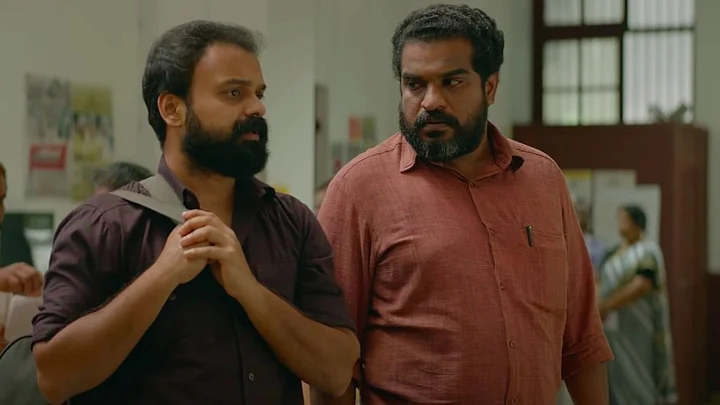On 4 October, 1996, Palakkad Collectorate was witness to some unusual drama that extended till dusk. On the pretext of submitting memorandums, four activists under the aegis of the 'Ayyankali Pada' reached the chamber of District Magistrate WR Reddy and held him captive, taking on the State. Their demand was that the EK Nayanar-led Left Democratic Front (LDF) government rollback its dilution of the Kerala Tribal Land Act of 1975, depriving tribals of their rightful procession. Director Kamal KM’s Pada is a dramatic recreation of what transpired then and its consequences.
Pada is a superb attempt not only because it is authentic and devoid of needless embellishments, but also on account of the research put in by the makers. Most importantly, Pada has its heart in the right place, and hopefully, will bring back the issue of the betrayal of Kerala tribals by successive governments into public discourse.
Apart from getting the casting right, Kamal KM manages to sustain the momentum throughout, without adding fictional bits to the narrative. The running time of two hours also works for it.
The names of the original activists – Kallara Jayan, Ajayan Mannur, Kanjangad Rameshan and Vilayodi Shivankutty – and the rest of the characters have been slightly altered, but the protagonists played by Kunchacko Boban, Vinayakan, Dileesh Pothan and Joju George bear some resemblance to their counterparts. The rest of the cast have also put in great performances, especially veterans such as TG Ravi, Indrans and Salim Kumar. VK Sreeraman who plays the role of EK Nayanar doesn’t really make a mark, and the talented Shine Tom Chacko is strangely wasted in a bit role. Kani Kusruthi and Unnimaya Prasad perform their parts well and Arjun Radhkrishnan as the DM is terrific. It is the casting of Prakash Raj as a non-Malayali top bureaucrat that is a bit strange, when CP Nair as chief secretary was pivotal in the behind-the-scenes activity.
Kamal KM should have also shed more light on the personal lives of the protagonists, to back up their politics, to convince the viewers about their just cause. It is the lived experiences of tribals and their exploitation at the hands of the settlers that cause them to take such unconventional routes. Furthermore, there is nobody to organise them or take up their cause as they make up just 1.4% of the total population of Kerala.
Today, if you were to go to Attappady, a block panchayat in Palakkad with the largest concentration of tribals (and larger in area than Alappuzha district), you would find settlers from Kottayam and elsewhere owning most of the land and establishments. How did this happen? The successive Left and Congress governments facilitated this for vote bank considerations. But the sorry state of affairs continued even after Kerala passed a unanimous legislation in 1975 to return lands of tribals going as far back as 1971, thus leading to further encroachments and squatting in the aftermath.
Things came to a head when the LDF and the Congress-led United Democratic Front (UDF) unanimously passed an amendment to push back the cut-off date of 1971 by 15 years and attempted further dilution of an act that had become part of the ninth schedule of the constitution. It is notable that the only dissenting voice in the state assembly was KR Gowri, Kerala’s first revenue minister, who had become expendable to the Communist Party of India (Marxist) by then.
The motley group that planned and executed the audacious hostage drama merely wanted to highlight the issue in the media and beyond, and they were successful in doing so, by bringing the state to its knees in the process.
In many ways it was the timely interventions of Chief Secretary CP Nair, as corroborated in biographies that saved the day, with an ailing and ageing Chief Minister EK Nayanar missing in action. Thrissur-based lawyer Veerachandra Menon who mediated between Ayyankali Pada and the State at the request of the former, Director General of Police Jacob Punnoose and then district judge also had a major role in averting the crisis.
Asianet News, Kerala’s only private news channel back then documented much of the hostage drama, after Ayyankali Pada demanded for the channel’s presence. In a bit of an anti-climax, ‘weapons’ used for holding the DM hostage was revealed in front of the press – a toy gun, bundles of thread made to resemble bombs, and some fire crackers – leaving the authorities red-faced.
It is a miracle that the hostage drama lasting nine hours ended without bloodbath or causality. It speaks of the humaneness and magnanimity of the people in command back then, unlike the petty-minded yes-men types occupying such positions today. WR Reddy, the DM who was taken hostage himself was most generous in not pressing charges against the gang of four. The Nayanar government reneged on its promise to not go on a witch-hunt, leading to the court delivering three-year sentences. Worse still, the plight of the tribals remains much the same, causing more displacements and misery to this day.
Kamal KM has managed to make a really good film without making compromises while ensuring that it doesn’t end up like a documentary. He deserves credit for attempting a film on such a topic, for a people still struggling to make their voice heard. Whether this film would make any change to their fortunes is debatable but it would at least make people take notice, which was among the goals of Ayyankali Pada.
Rating: 4 Quints Out of 5
(At The Quint, we question everything. Play an active role in shaping our journalism by becoming a member today.)
